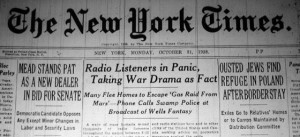Hello again, it’s Jeff here to talk about Nichelle Nichols, who was born on December 28, 1932. I, like most people, knew Nichelle from her role as Uhura in Star Trek and didn’t think much beyond that. When Barbara asked me to write a post about Gene Roddenberry I found out through my research that after the network refused to give Nichelle a contract he kept her on at a week to week basis. In trying to confirm this I ended up doing further research on Nichelle and became fascinated by her life story.
Nichelle, who’s birth name is Grace Dell Nichols, was born in Robbins Illinois, originally a small town south of Chicago, but now part of the greater Chicago metro area. The area was first proposed as a suburb of Chicago in the early 1890s and lots were sold to whites at exorbitant prices with the expectation that Chicago would grow that way after the World’s Columbian Exposition, but the city did not grow as anticipated and most of the speculators lost their investments. In the early 1900s Henry Robbins acquired the land and began marketing it to African Americans. The town grew and had a population of 300 by 1917 when it was officially incorporated, one of the first towns to be incorporated by African Americans and one of the few towns. The town supported one of the few airports that allowed African American pilots. This airport, which was destroyed by a tornado in 1933, was the model for the Tuskegee Airmen. The town was also a hotspot for African Americans from Chicago supporting green spaces for picnics and an active nightclub scene. By 2010 the population was 5,337 with 96% of the inhabitants African American and it is one of the poorer Chicago suburbs. This being said, for so small a town, it has produced a number of notable celebrities, including Nichelle, Dwyane Wade, Joe Montgomery, James Loving and Shaun Wiggins.
Nichelle’s was a gifted dancer who started ballet when she was 7. When she was 14 she auditioned for the Chicago Ballet Academy. At first the instructor refused to let her audition because “Black people can’t dance ballet.” After her father insisted that she would be able to audition, she did and was admitted to the dance school. During this time she also took Afro-Cuban dance lessons and started getting jobs in hotels. She was discovered by Duke Ellington and started touring with him. By the end of the tour she was the lead singer and her career kept growing from there. In the mid 50’s she had earned enough money to move her extended family to Los Angeles where she could focus on her career in television, which lead to Star Trek role and her current fame.
Her role in Star Trek wasn’t what I found so interesting though. Instead it was her commitment to being a role model that caught my eye. After the first year of Star Trek she was ready to quit. The network was treating her as a second class citizen and constantly downgrading her role. The same week that she told Gene of her intentions she also attended a NAACP fund raiser. There she met Dr. Martin Luther King who told her:
You have opened a door that must not be allowed to close. I’m sure you have taken a lot of grief, but you changed the face of television forever. You have created a character of dignity and grace and beauty and intelligence. Don’t you see that you’re not just a role model for little black children? You’re more important for people who don’t look like us. For the first time, the world sees us as we should be seen, as equals, as intelligent people–as we should be…Remember, you are not important there in spite of your color. You are important there because of your color.
This changed her mind about quitting and she stayed on the show until it was cancelled, but never stopped being an inspiration to the black community. In the 70’s she gave a speech criticizing NASA for not selecting women and people of color to the astronaut programs. NASA challenged her to help with the recruitment effort. In response she created Women in Motion, a company dedicated to attracting minority candidates to the space program. While it is hard to say the direct impact she had, the number of applicants jumped from 1,500 to 8,000 during this time and we do know she directly inspired Dr. Mae Jemison, the first black woman in space, as well as Col. Guion Bluford, Dr. Ronald McNair and Dr. Sally Ride. She also inspired Charles Bolden who is now the Administrator of NASA.
Finally, she is a member of the board of Governors of the National Space Society and actively works to get kids interested in Science and Technology, something I really support! It has been a lot of fun researching Nichelle. If you have a minute take a look at these short interview clips or check out her autobiography Beyond Uhura – Star Trek and Other Memories. Maybe some day I will be lucky enough to meet her in person!
Here are some of her works if you don’t already have them:
Jeff Jones







